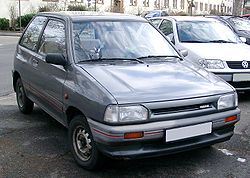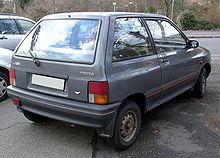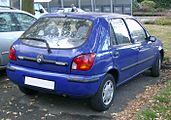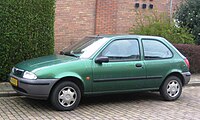Mazda 121
| Mazda 121 | |
|---|---|
| Production period: | 1988-2003 |
| Class : | Small car |
| Body versions : | Limousine , station wagon |
| Successor: | Mazda2 |
The Mazda 121 is a small car produced by the Japanese automobile manufacturer Mazda . The 121 was built from the beginning of 1988 to spring 2003, when production ceased with the introduction of the Mazda 2 . The 121 was modeled twice during its construction period.
121 (type DA, 1988–1991)
| 1st generation | |
|---|---|
|
Mazda 121 three-door (1988–1991) |
|
| Production period: | 1988-1991 |
| Body versions : | Station wagon |
| Engines: |
Petrol engines : 1.1–1.4 liters (40–44 kW) |
| Length: | 3475-3580 mm |
| Width: | 1605-1615 mm |
| Height: | 1450-1515 mm |
| Wheelbase : | 2295 mm |
| Empty weight : | 700-800 kg |
The first generation of the 121, which was built from the beginning of 1988 to spring 1991 and called DA , was a joint project with Ford and Kia , with the Mazda being similar to the Kia Pride and the Ford Festiva .
The equipment of the 121 was relatively sparse (there was no central locking, no electric windows and no power steering), but it impressed with a cleverly thought-out room concept. Despite its compact dimensions, the interior was sufficient, even in the rear. This was achieved by a sliding back seat. The mechanism (analogous to a front seat) could be operated both from the rear and from the trunk. This made it possible to gain around 20 cm in length with a larger load in the trunk. Furthermore, the backrests of the seats in the rear could not only be folded down forwards, but also backwards. This made it possible to achieve a complete lying surface by including the front seats (after removing the headrests).
The 121 DA was also available with an electric fabric folding roof, the so-called canvas top, as the Mazda 121 CT.
- Engines
- 1.1 with 1139 cm³, 42 kW (1988–1990)
- 1.3 with 1324 cm³, 40 kW (1989–1991)
- 1.3 with 1324 cm³, 44 kW (1988–1990)
121 (type DB, 1991–1996)
| 2nd generation | |
|---|---|
|
Mazda 121 (1991-1996) |
|
| Production period: | 1991-1996 |
| Body versions : | limousine |
| Engines: |
Petrol engines : 1.3 liters (39–54 kW) |
| Length: | 3800-3810 mm |
| Width: | 1655 mm |
| Height: | 1470-1495 mm |
| Wheelbase : | 2390 mm |
| Empty weight : | 800-850 kg |
The DB , which was built from spring 1991 to the beginning of 1996 (outside Europe: Autozam Revue ), was a Mazda in-house development and had a notchback rather than an angled. Because of their rounded appearance, this generation is often given nicknames such as “egg”, “cheese bell”, “humpback” or “bubble car”. The idea of the design was to have no rough edges in the car. This idea was also largely implemented.
In contrast to its predecessor, the interior of the DB was better and better processed. There was also, depending on the model, more extensive equipment such as B. an illuminated ignition lock, central locking and front electric windows. This model was also available with air conditioning. Like its predecessor, the DB was also available with a canvas top. However, in contrast to the DA, this could be opened from front to back as well as from back to front. Apart from the engine, the model variants also differ in their paintwork; While the bumpers were made of black plastic on the entry-level model, they were painted in the same color as the car on the more powerfully motorized model. The same was true for the side mirrors.
- Engines
- 1.3 16V with 1324 cm³, 39 kW (52 PS), Euro 1
- 1.3 16V with 1324 cm³, 54 kW (72 PS), Euro 1
121 (type JASM / JBSM, 1996-2003)
| 3rd generation | |
|---|---|
|
Mazda 121 five-door (1996-2000) |
|
| Production period: | 1996-2003 |
| Body versions : | Station wagon |
| Engines: |
Otto engines : 1.2–1.3 liters (37–55 kW) Diesel engines : 1.8 liters (44–55 kW) |
| Length: | 3828 mm |
| Width: | 1634 mm |
| Height: | 1334 mm |
| Wheelbase : | 2445 mm |
| Empty weight : | 1005-1038 kg |
In March 1996, the DB was replaced by the third generation known as JASM (five-door) or JBSM (three-door). This was again a joint development with Ford. This time it shared the technical basis as well as the exterior design with the Fiesta '96 . Both models could only be distinguished by the brand logo and slightly modified front and rear aprons.
At the beginning of 2000 the Mazda 121 received a facelift, among other things the vehicles were now equipped with new lights and modified aprons. However, the differences between the two models remained minor.
In contrast to the popular Fiesta, the 121 of the third generation was never a great sales success. In April 2003 it was finally replaced by the Mazda 2 .
- Engines
- 1.3 with 1299 cm³, 37 kW (50 PS)
- 1.3 with 1299 cm³, 44 kW (60 PS)
- 1.25 16V with 1242 cm³, 55 kW (75 PS)
- 1.8D with 1753 cm³, 44 kW (60 PS)
- 1.8TD with 1753 cm³, 55 kW (75 PS)
| Mazda 121 1996-2003 | |||||
|---|---|---|---|---|---|
| 1.25 i 16V (1996-2003) |
1.3 i (1996-2003) |
1.8 D (1996-2000) |
1.8 Tue (2000-2003) |
||
| Engine: | 4-cylinder in-line engine (four-stroke) | ||||
| Engine type: | Zetec-SE | Endura-E | Endura-DE | Endura-DI | |
| Displacement: | 1242 cc | 1299 cc | 1753 cc | ||
| Bore × stroke: | 71.9 x 76.5 mm | 74 x 75.5 mm | 82.5 × 82 mm | ||
| Performance at 1 / min: |
55 kW (75 PS) 5200 |
37 kW (50 hp) 4500 |
44 kW (60 PS) 5000 |
44 kW (60 hp) 4800 |
55 kW (75 PS) 4000 |
| Max. Torque at 1 / min: |
110 Nm 4000 |
94 Nm 2500 |
103 Nm 2500 |
105 Nm 2500 |
140 Nm 1900 |
| Mixture preparation: | Electronic injection | Diesel injection pump | Diesel injection pump, Garrett turbocharger | ||
| Valve control: | DOHC , timing belt | OHV , side. Camshaft, chain | OHC, timing belt | ||
| Cooling: | Water cooling | ||||
| Transmission: | 5-speed gearbox (1.25i aW with continuously variable CTX automatic) |
||||
| Front suspension: | MacPherson struts, wishbones, coil springs | ||||
| Rear suspension: | Twist beam axle, coil springs | ||||
| Body: | Sheet steel, self-supporting | ||||
| Track width front / rear: | 1429/1373 mm | ||||
| Wheelbase: | 2445 mm | ||||
| Length: | 3828 mm | ||||
| Empty weight: | 930-1015 kg | ||||
| Top speed: | 160-170 km / h | 143-153 km / h | 155 km / h | 168 km / h | |
| Acceleration 0-100 km / h: |
12.7-15.6 s | 15.9-19.5 s | 17.4 s | 14.3 s | |
| Consumption (liters / 100 kilometers): | 6.4-6.7 S. | 6.4 S | 5.7D | 5.0 D | |






